Welcome to our free classical music site

Do you write about classical music? Are you a blogger? Want to team up with Classical Connect? Send us a message, let's talk!

Do you write about classical music? Are you a blogger? Want to team up with Classical Connect? Send us a message, let's talk!
December 30, 2013. End of 2013. Throughout the year we wrote about composers whose birth dates were lost in subsequent centuries. Most of them came from the early Renaissance period: by the time of the Baroque record keeping had greatly improved. We’d like to finish 2013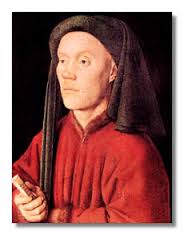 with a mention of two more composers who, if not very well known today, have greatly affected the course of musical history.
with a mention of two more composers who, if not very well known today, have greatly affected the course of musical history.
Gilles Binchois was born around 1400 in the city of Mons, which is now in Belgium and back then was the capital of the County of Hainaut. It later became part of the Duchy of Burgundy. During the Hundred Years’ War the Burgundians fought on the side of the English, and at some point even captured Paris. It’s known that around 1425 Binchois was in Paris serving William de la Pole, earl of Suffolk and one of the English commanders during the War. Around 1430 Binchois joined the court chapel of Philip the Good, the Duke of Burgundy and stayed there for many years. Philip loved the music and in addition to Binchois hired another famous composer, Guillaume Dufay. Philip didn’t have a permanent capital and moved his court between the palaces in Brussels, Bruges, Dijon and other cities of the Duchy; Binchois most likely traveled with the court. Eventually he retired to Soignies, just outside of Mons. He died in 1460. Binchois was considered the finest melodist of the 15th century, although some might argue that this honor belongs to John Dunstaple, and was, with Guillaume Dufay, the most significant composer of the early Burgundian (Franco-Flemish) School.
Here is his song (rondeau) Dueil angoisseux, or Anguished grief. For the text Binchois used a poem by Christine de Pizan, an Italian poet (she was born in Venice in 1365) who mostly worked in the courts of the French and Burgundian dukes. It’s performed by the eponymous ensemble, Ensemble Gilles Binchois. And here is another chanson, Triste plaisir et douloureuse joye (Sad pleasure and sorrowful joy). The Swedish mezzo/contralto Lena Susanne Norin is accompanied by Randall Cook on viola da gamba with Susanne Ansorg playing rebec, a predecessor of the violin. The portrait of a man, above left, was painted in 1432 by the most famous Netherlandish painter of the time, Jan van Eyck. Like Guillaume Dufay and Binchois, he also served in the court of Philip the Good. The German art historian Erwin Panofsky believed that this could’ve been a portrait of Gilles Binchois.
A century and a half later, another representative of the Franco-Flemish school ruled the musical world. His name was Orlando di Lasso. Like Binchois, Orlando was also born in Mons, probably in 1532. Orlando spent many years in Italy and, with his work, influenced the music in that country and elsewhere in Europe.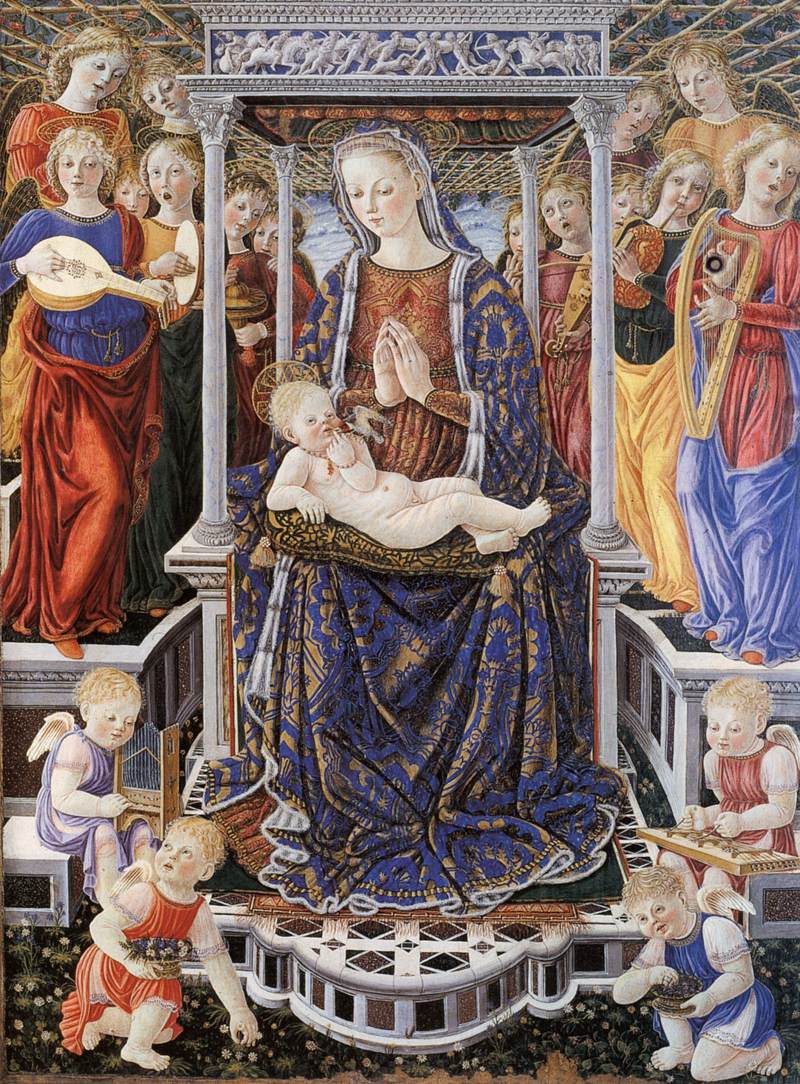 We’ll dedicate a separate entry to this talented and very prolific composer, who wrote more than 2000 pieces, from the madrigals and chansons to motets, masses and magnificats. For now, we’ll just present a song of a particular type called villanelle, which consists of 19 lines: five tercets and a quatrain. This one, called Matona, mia cara (My dear lady, I’d love to sing a song below your window), depicts a bawdy German lancer and is set to a text that it too risqué to be reproduced on these pages. But the music is absolutely charming. Listen to it in the performance by the Douglas Frank Chorale. The Madonna and Child Enthroned with Music-Making Angels is by Giovanni Boccati, an Italian painter from Camerino in the Marche, and was painted in 1455.
We’ll dedicate a separate entry to this talented and very prolific composer, who wrote more than 2000 pieces, from the madrigals and chansons to motets, masses and magnificats. For now, we’ll just present a song of a particular type called villanelle, which consists of 19 lines: five tercets and a quatrain. This one, called Matona, mia cara (My dear lady, I’d love to sing a song below your window), depicts a bawdy German lancer and is set to a text that it too risqué to be reproduced on these pages. But the music is absolutely charming. Listen to it in the performance by the Douglas Frank Chorale. The Madonna and Child Enthroned with Music-Making Angels is by Giovanni Boccati, an Italian painter from Camerino in the Marche, and was painted in 1455.
Happy New Year!Permalink
December 23, 2013. Christmas of 2013. We at Classical Connect wish all our listeners a very merry Christmas! As became a tradition, we celebrate Christmas with Bach’s Christmas Oratorio. Here are movements 2 through 4 of Part I: For the First Day of Christmas. The Evangelist, whose role is to read from the Bible,.jpg) narrates from Luke 2:1 “And it came to pass in those days, that there went out a decree from Caesar Augustus, that all the world should be taxed.” It’s followed by the Alto recitative “Now shall my beloved bridegroom” and then the wonderful aria “Prepare thyself, Zion.” The Evangelist is the German tenor Christoph Genz, the Alto – Argentinean mezzo-soprano Bernarda Fink. John Eliot Gardiner conducts the English Baroque Soloists and Monteverdi Choir. The Nativity scene at the left is by Fra Angelico, from a cell of the monastery of San Marco in Florence. It was painted around 1440-41, almost 300 years before Bach composed the Oratorio.
narrates from Luke 2:1 “And it came to pass in those days, that there went out a decree from Caesar Augustus, that all the world should be taxed.” It’s followed by the Alto recitative “Now shall my beloved bridegroom” and then the wonderful aria “Prepare thyself, Zion.” The Evangelist is the German tenor Christoph Genz, the Alto – Argentinean mezzo-soprano Bernarda Fink. John Eliot Gardiner conducts the English Baroque Soloists and Monteverdi Choir. The Nativity scene at the left is by Fra Angelico, from a cell of the monastery of San Marco in Florence. It was painted around 1440-41, almost 300 years before Bach composed the Oratorio.
We also want to mark the birthday of Orlando Gibbons, an English composer baptized on 25 December 25th, 1583. He was one of the last Renaissance English composers, following in the steps on John Dunstaple, JohnTaverner, Thomas Tallis, William Byrd, John Dowland, and many other composers of that great national school. What followed shortly after was the dawn of the baroque era that in England culminated in the art of Henry Purcell and Georg Frideric Handel. Gibbons was born in Oxford into a musical family: his father William was one of the waits in Cambridge (waits were town pipers whose duties included playing loud music to wake townsfolk in the morning; they also participated in processions and greeted the visiting royalty). Four of William’s sons were musicians. At the age of 21 Orlando was made the organist at Chapel Royal. He was also a virtuoso performer on the virginal, a type of harpsichord popular at the time both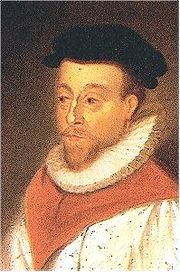 in England and elsewhere in Europe. In England the “Virginalist school” came into being at the end of the 16th - beginning of the 17th century; at about the same time Girolamo Frescobaldi in Italy and Jan Pieterszoon Sweelinck in the Netherlands created many works for that instrument.
in England and elsewhere in Europe. In England the “Virginalist school” came into being at the end of the 16th - beginning of the 17th century; at about the same time Girolamo Frescobaldi in Italy and Jan Pieterszoon Sweelinck in the Netherlands created many works for that instrument.
Gibbons, a prolific composer, wrote a number of motets and so-called "anthems," in which a solo voice alternated with the full choir, while the organ provides the accompaniment. One of the most famous is This is the record of John (John is the title refers to John the Baptist). Here it is performed by Robin Blaze, Countertenor, Winchester Cathedral Choir, with Sarah Baldock on the organ; David Hill is conducting. Very popular at the time was his short madrigal The silver swan, performed here by the Rose Consort of Viols with the vocal ensemble Red Byrd. And here is Gibbons’s "Lord of Salisbury" Pavan and Galliard. It’s performed on a modern piano by Glenn Gould. Gibbons was one of Gould’s favorite composers (another, of course, was Johann Sebastian Bach).
PermalinkDecember 16, 2013. Ludwig van Beethoven was born on this day in 1770 in Bonn, or at least we presume he was: the only existing record is that of his baptism, which happened on December 17th. We wrote about Beethoven many times (here, for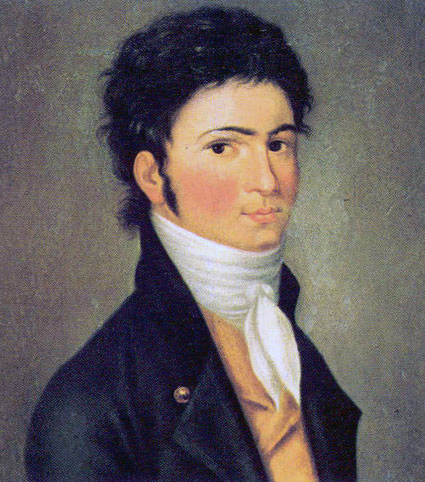 example), so we’ll just continue the traversal of his piano sonatas, this time sonatas nos. 2 and 3, Op. 2. Both are dedicated to Franz Joseph Haydn. Beethoven met Haydn in the summer of 1792 in Bonn. In November of the same year he moved to Vienna to study with the great composer. A piano child prodigy, at the age of 21 he was already well know as an incomparable piano improviser. Even though he was composing from the age of 13 and by the time of his arrival in Vienna had written a number of pieces, Beethoven understood that as composer he had many technical shortcomings and needed to study. In addition to taking composition lessons with Haydn, he studied counterpoint with Johann Georg Albrechtsberger, the organist at the St-Stephen’s cathedral, as well as the violin with a friend, the violinist Ignaz Schuppanzigh. He also worked with the composer Antonio Salieri. In Vienna Beethoven established himself as a piano virtuoso, performing in private salons. He often played preludes and fugues from Bach’s Well-Tempered Clavier. He continued to compose, both on the large and small scale but without presenting or publishing most of his music. When he was just 13, while still in Bonn, he composed a piece that is known as his "Concerto no. 0." He wrote down the piano part but didn’t complete the orchestral score, so when the concerto was performed, the rest of the orchestral part had to be arranged on the fly. This concerto is practically never performed these days. Also around that time he wrote several piano sonatas, strongly influenced by the style of the Mannheim school, with sudden bursts of forte and unexpected pianos (we wrote about Carl Stamitz, probably the most interesting representative of this school, here). Then, between 1787 and 1789 he wrote the large sections of yet another piano concerto, which he completed in Vienna in 1795. We know it as his Concerto no. 2. There is confusion surrounding his first two "official" piano concertos: their numbers come not from the sequence in which they were composed but in which they were published. The concerto known as number 1 was actually composed in 1796-97; both concertos were published years later, Concerto no. 1 first, as opus 15 and then Concerto no. 2 as opus 19. In 1795, in a “coming of age” concert, Beethoven’s first public appearance in Vienna, he played his own composition, piano concerto no. 2. Soon after he published his first officially numbered composition, a set of piano trios, Op. 1. Three piano sonatas followed, his opus 2.
example), so we’ll just continue the traversal of his piano sonatas, this time sonatas nos. 2 and 3, Op. 2. Both are dedicated to Franz Joseph Haydn. Beethoven met Haydn in the summer of 1792 in Bonn. In November of the same year he moved to Vienna to study with the great composer. A piano child prodigy, at the age of 21 he was already well know as an incomparable piano improviser. Even though he was composing from the age of 13 and by the time of his arrival in Vienna had written a number of pieces, Beethoven understood that as composer he had many technical shortcomings and needed to study. In addition to taking composition lessons with Haydn, he studied counterpoint with Johann Georg Albrechtsberger, the organist at the St-Stephen’s cathedral, as well as the violin with a friend, the violinist Ignaz Schuppanzigh. He also worked with the composer Antonio Salieri. In Vienna Beethoven established himself as a piano virtuoso, performing in private salons. He often played preludes and fugues from Bach’s Well-Tempered Clavier. He continued to compose, both on the large and small scale but without presenting or publishing most of his music. When he was just 13, while still in Bonn, he composed a piece that is known as his "Concerto no. 0." He wrote down the piano part but didn’t complete the orchestral score, so when the concerto was performed, the rest of the orchestral part had to be arranged on the fly. This concerto is practically never performed these days. Also around that time he wrote several piano sonatas, strongly influenced by the style of the Mannheim school, with sudden bursts of forte and unexpected pianos (we wrote about Carl Stamitz, probably the most interesting representative of this school, here). Then, between 1787 and 1789 he wrote the large sections of yet another piano concerto, which he completed in Vienna in 1795. We know it as his Concerto no. 2. There is confusion surrounding his first two "official" piano concertos: their numbers come not from the sequence in which they were composed but in which they were published. The concerto known as number 1 was actually composed in 1796-97; both concertos were published years later, Concerto no. 1 first, as opus 15 and then Concerto no. 2 as opus 19. In 1795, in a “coming of age” concert, Beethoven’s first public appearance in Vienna, he played his own composition, piano concerto no. 2. Soon after he published his first officially numbered composition, a set of piano trios, Op. 1. Three piano sonatas followed, his opus 2.
The second of these sonatas, no 2 in A Major, consists of four movements: Allegro vivace; Largo appassionato; Scherzo: Allegretto; and Rondo: Grazioso. Karl Hass, whose Adventures in Good Music was the most listened to classical music program ever produced, used the touching Largo appassionato as the musical theme (Mr. Haas’s 100th birthday was just 10 days ago, on December 6th: he was born on that day in 1913 in Speyer, Germany). You can hear Sonata op.2 no. 2 in the performance by Emil Gilels. The 3rd sonata, which followed shortly after, in C Major, is usually the longest of the three (it runs for about 25 minutes, although Gilels manages to stretch sonata no. 2 to the same length) and technically the most difficult. It also has four movements: Allegro con brio, Adagio, Scherzo: Allegro, and Allegro assai. You can hear it in the performance by Richard Goode. Both sonatas are immediately recognizable as Beethoven’s, even if they lack the depth he developed later in his career. With their surprising and unpredictable outbursts, as for example in the slow movement of the 3rd sonata, they owe more to the Mannheim school than to the dedicatee, Haydn, or Beethoven’s idol, Mozart.
PermalinkDecember 9, 2013. Franck, Messiaen, Berlioz. This year the birthdays of these three francophone composers again fell on the same week. César Franck was born on December 10th, 1822 in Liège, but spent most of his life in Paris. One of the greatest composers of the 20th century, Olivier Messiaen was born on the same day in 1908 in Avignon, and Hector Berlioz – on December 11th, 1803 in La Côte-Saint-André, near Grenoble. We wrote extensively about Franck last year. His violin sonata remains one of the most popular pieces both among musicians and listeners: we have 10 recordings of it with violin soloists and two arrangements, one for the cello and another for the viola. Here the sonata is played by the German violinist Augustin Hadelich with Yingdi Sun on the piano.
Olivier Messiaen’s life consisted of contradictions that produced extraordinarily creative results: deeply religious, somewhat conservative, and inspired by life of St Francis, he wrote music in an idiom all his own, absolutely modern and original. His experience during WWII was traumatic; conscripted, he was captured by the Germans at the beginning of the war and imprisoned in a camp. There he wrote Quatuor pour la fin du temps ("Quartet for the End of Time") (you can read more here). He was released in May of 1941 and soon after appointed a professor at the Conservatory of the occupied Paris. All along he was working as the organist at the church of La Trinité. In 1944, during the terrible last months of the German occupation, he composed a piano cycle called Vingt regards sur l'enfant-Jésus, which could be translated as “Twenty contemplations (or gazes) on the infant Jesus.” He dedicated it to his pupil, and later wife, the pianist Yvonne Loriod. One of his religious works, it consists of twenty episodes with titles such as "Contemplation of the Father," "Contemplation of the star," "Contemplation of the Virgin," and so on. The complete duration of this enormous piece is more than two hours. We’ll listen to the first part, Contemplation of the Father (here). It’s performed by the French pianist Pierre-Laurent Aimard, who studied with Yvonne Loriod at the Paris Conservatory.
Even though Messiaen inspired and influenced many composers (among his students were some of the most important composers of the second half of the 20th century: Pierre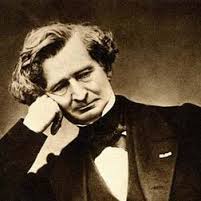 Boulez, Karlheinz Stockhausen, Iannis Xenakis) his musical style was unique. In this respect he reminds us of another Frenchman, Hector Berlioz. Born in a small town into a family of a physician, Berlioz didn’t start studying music till he was 12. His father didn’t encourage his musical studies, and at the age of 18 Hector went to Paris to study medicine, in which he had no interest. After hearing several operas (he was not a diligent student and spent much of his time looking for entertainment) he went to the library of the Paris Conservatory and studied the scores. In 1824 he abandoned his medical studies and started composing on a more regular basis. Two years later, in 1824 when he was 23, he began attending classes at the Conservatory. By then he was a fully formed composer, and winning the Prix du Rome became an important goal, not the least because it included a five-year stipend. He got it only on his forth attempt, in 1830. About the same time he also got engaged to the 20 year-old pianist Marie Moke, to whom Chopin, Liszt and Mendelssohn dedicated various compositions. At the very end of 1831 Berlioz went to Italy, as was a requirement for all Prix du Rome winners. He stayed in the Villa Medici of the French Academy and didn’t like Rome (“a stupid and prosaic city,” he called it). Moreover, he got the news from his fiancée’s mother that Marie broke their engagement and was to marry Camille Pleyel, the son of Ignaz Pleyel, the famous publisher and piano maker. He decided to kill both his former fiancée, her mother – the bearer of the news -- and Pleyel, and concocted an elaborate plan to do so. Fortunately to everybody involved, on the way from Rome to Paris it occurred to him how foolish the plan was and he returned to Rome. In 1830, while still in Paris, Berlioz wrote what was to become one of his most famous compositions, Symphony Fantastique: Épisode de la vie d'un Artiste, en cinq parties (Fantastic Symphony: An Episode in the Life of an Artist, in Five Parts). Here is the second movement Un Bal (A ball). In this 1974 recording Colin Davis is conducting the Royal Concertgebouw Orchestra (here is the first movement, Rêveries – Passions or Daydreams – Passions, with Rundfunk-Sinfonieorchester Berlin under the direction of Igor Markevitch).
Boulez, Karlheinz Stockhausen, Iannis Xenakis) his musical style was unique. In this respect he reminds us of another Frenchman, Hector Berlioz. Born in a small town into a family of a physician, Berlioz didn’t start studying music till he was 12. His father didn’t encourage his musical studies, and at the age of 18 Hector went to Paris to study medicine, in which he had no interest. After hearing several operas (he was not a diligent student and spent much of his time looking for entertainment) he went to the library of the Paris Conservatory and studied the scores. In 1824 he abandoned his medical studies and started composing on a more regular basis. Two years later, in 1824 when he was 23, he began attending classes at the Conservatory. By then he was a fully formed composer, and winning the Prix du Rome became an important goal, not the least because it included a five-year stipend. He got it only on his forth attempt, in 1830. About the same time he also got engaged to the 20 year-old pianist Marie Moke, to whom Chopin, Liszt and Mendelssohn dedicated various compositions. At the very end of 1831 Berlioz went to Italy, as was a requirement for all Prix du Rome winners. He stayed in the Villa Medici of the French Academy and didn’t like Rome (“a stupid and prosaic city,” he called it). Moreover, he got the news from his fiancée’s mother that Marie broke their engagement and was to marry Camille Pleyel, the son of Ignaz Pleyel, the famous publisher and piano maker. He decided to kill both his former fiancée, her mother – the bearer of the news -- and Pleyel, and concocted an elaborate plan to do so. Fortunately to everybody involved, on the way from Rome to Paris it occurred to him how foolish the plan was and he returned to Rome. In 1830, while still in Paris, Berlioz wrote what was to become one of his most famous compositions, Symphony Fantastique: Épisode de la vie d'un Artiste, en cinq parties (Fantastic Symphony: An Episode in the Life of an Artist, in Five Parts). Here is the second movement Un Bal (A ball). In this 1974 recording Colin Davis is conducting the Royal Concertgebouw Orchestra (here is the first movement, Rêveries – Passions or Daydreams – Passions, with Rundfunk-Sinfonieorchester Berlin under the direction of Igor Markevitch).
PermalinkDecember 2, 2013. Soler, Geminiani and Sibelius. Francesco Geminiani was born in Lucca on December 5th, 1687. He studied music with Alessandro Scarlatti and later with Arcangelo Corelli. In 1711 he became the leader of the Opera orchestra of Naples,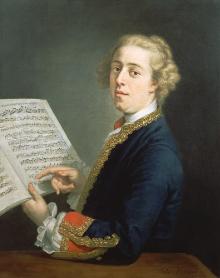 where he was also the concertmaster. His teacher Scarlatti was living (and writing operas) in Naples during that time, so they resumed their contacts. In 1714 Geminiani moved to London. By then he had a reputation as a violin virtuoso. George Frideric Handel, who also studied with Corelli, was the king of the London music scene. All things Italian were very popular in London in those days (the tradition of a young gentleman’s Grand Tour with its obligatory stops in Florence, Rome, and also Venice and Naples, was established at the end of the 17th century), and Geminiani was invited to the court of George I. There he played the violin accompanied by Handel himself. Geminiani lived in England and Ireland for the rest of his life (he died in Dublin on September 17th, 1762). He had many students and in 1751 published an influential book on violin playing, Art of Playing the Violin. Among his best-known compositions are concerti grossi, some of them based on the music of his teacher Corelli. Here, for example is Geminiani’s Concerto Grosso no. 12 in D minor "La Follia," which was based on Corelli’s Violin sonata op.5 no. 12, which in turn was based on the famous tune, La Folia. It’s performed by The English Concert, Trevor Pinnock conducting. And here is his Concerto Grosso op. 7 no. 3. It’s performed by Capella Istropolitana, Jaroslav Krcek conducting.
where he was also the concertmaster. His teacher Scarlatti was living (and writing operas) in Naples during that time, so they resumed their contacts. In 1714 Geminiani moved to London. By then he had a reputation as a violin virtuoso. George Frideric Handel, who also studied with Corelli, was the king of the London music scene. All things Italian were very popular in London in those days (the tradition of a young gentleman’s Grand Tour with its obligatory stops in Florence, Rome, and also Venice and Naples, was established at the end of the 17th century), and Geminiani was invited to the court of George I. There he played the violin accompanied by Handel himself. Geminiani lived in England and Ireland for the rest of his life (he died in Dublin on September 17th, 1762). He had many students and in 1751 published an influential book on violin playing, Art of Playing the Violin. Among his best-known compositions are concerti grossi, some of them based on the music of his teacher Corelli. Here, for example is Geminiani’s Concerto Grosso no. 12 in D minor "La Follia," which was based on Corelli’s Violin sonata op.5 no. 12, which in turn was based on the famous tune, La Folia. It’s performed by The English Concert, Trevor Pinnock conducting. And here is his Concerto Grosso op. 7 no. 3. It’s performed by Capella Istropolitana, Jaroslav Krcek conducting.
Antonio Soler was born on December 3rd, 1729 in a small Catalan town of Olot. There is a connection between Soler and Geminiani: the former studied with Domenico Scarlatti, while the latter – with Domenico’s father Alessandro. Soler went to the choir school of the monastery of Monserrat and soon after was made chapel master at the Lerida Cathedral. In 1752 he joined the Order of St. Jerome (therefore “Padre” or “Father” Soler, as he’s commonly called) and became the organist at the royal Monastery of El Escorial. While there he wrote more than 500 compositions, among them 150 keyboard sonatas, many of them highly original, with unexpected harmonic developments (it’s rumored, though, that some of the sonatas were actually written by his pupil, Infante Gabrile, son of the king Carlos III). Soler also wrote church music and music for plays, but it’s his keyboard sonatas that he’s famous for. Here are three sonatas by Soler, performer by the great Spanish pianist Alicia de Larrocha: F-sharp minor R 85; in D Major R86, and F-sharp major R 90.
Jean Sibelius is another composer who has his birthday this week. He was born on December 8th, 1865 in Hämeenlinna, not far from Helsinki in what was then part of the Russian Empire. The first thing that comes to mind when one compares the work of Sibelius with the baroque composers like Geminiani and Soler is not the difference in style, which of course is enormous, – it’s the intensity and seriousness of purpose. For Sibelius, a Finnish nationalist whose first language was Swedish, Finland’s independence was paramount, and while he couldn’t do much about it politically, he attempted to create it in his music; his Symphony no. 2 was dubbed “The Symphony of Independence.” As a composer he was a master, building his work as a progression of different elements and fragments. In this respect, his recollection of a conversation with Gustav Mahler, whom he met in 1907 while Mahler was touring Finland, is very telling for our understanding of both composers. “I said that I admired [the symphony's] severity of style and the profound logic that created an inner connection between all the motifs... Mahler's opinion was just the reverse. 'No, a symphony must be like the world. It must embrace everything.’” It couldn’t be said better: Mahler’s symphonies are like the world, and Sibelius’s are logical. Sibelius composed his Symphony no. 5 in 1915; the symphony was commissioned by the Finnish Government to commemorate Sibelius’s 50th birthday, and it was premiered on that date, December 8th, 1915 in Helsinki. In this recording Herbert von Karajan conducts the Berlin Philharmonic (here).Permalink
November 25, 2013. Lully and Donizetti. Just a couple of weeks ago we wrote about François Couperin and Vincenzo Bellini and here we are, celebrating yet another of the French Baroque greats and a very important Italian composer of the bel canto. In our notes the French Baroque fared the best, as in the last couple of months we also wrote about Marc-Antoine Charpentier and Jean-Philippe Rameau. But at the beginning of it was the Italian, Jean-Baptiste Lully. Lully was born on November 28, 1632 in Florence and christened Giovanni Battista. He was brought to France at the age of 14 to serve at the court of Mademoiselle de Montpensier (la Grande Mademoiselle), the granddaughter of the King Henry IV and Marie do Medici. Mademoiselle, one of the richest women in France, was famous for her patronage of the arts and had many household musicians. Young Lully probably studied music with some of them. After Mademoiselle was exiled from the capital during the Fronde, Lully received her permission to return to Paris, where very soon he was hired as the violinist and composer at the court of Louis XIV. He stayed with the court for the rest of his life, although Louis’ affection cooled considerably after Lully was caught in a liaison with a male page. Highly ambitious, Lully sought titles and positions all his life. He held many royal appointments and even became a secrétaire du roi, usually reserved for the French nobility. He also bought a royal patent for operatic productions, and from 1674 no opera could be staged in France without his permission.
notes the French Baroque fared the best, as in the last couple of months we also wrote about Marc-Antoine Charpentier and Jean-Philippe Rameau. But at the beginning of it was the Italian, Jean-Baptiste Lully. Lully was born on November 28, 1632 in Florence and christened Giovanni Battista. He was brought to France at the age of 14 to serve at the court of Mademoiselle de Montpensier (la Grande Mademoiselle), the granddaughter of the King Henry IV and Marie do Medici. Mademoiselle, one of the richest women in France, was famous for her patronage of the arts and had many household musicians. Young Lully probably studied music with some of them. After Mademoiselle was exiled from the capital during the Fronde, Lully received her permission to return to Paris, where very soon he was hired as the violinist and composer at the court of Louis XIV. He stayed with the court for the rest of his life, although Louis’ affection cooled considerably after Lully was caught in a liaison with a male page. Highly ambitious, Lully sought titles and positions all his life. He held many royal appointments and even became a secrétaire du roi, usually reserved for the French nobility. He also bought a royal patent for operatic productions, and from 1674 no opera could be staged in France without his permission.
While engaged in the intrigue, he still managed to produce a huge volume of music. As long as the King was interested in dancing, it was mostly ballets (Lully himself was a very good dancer), but later he turned to opera or “tragedy set to music.” Lully introduced livelier dances to the ballets, got rid of “recitative secco” of the traditional Italian operas, in which declamation was accompanied only by the continuo, and adopted “accompagnato,” in which the orchestra is accompanying the singer. All these innovations made his music so much freer, both rhythmically and melodically. For a number of years Lully collaborated with Molière and wrote a number of “interludes” to his plays. He also composed some sacred music, six motets among them. The opera Alceste, ou Le triomphe d’Alcide was composed to celebrate the capture of Franche-Comté from Spain and premiered in 1674. Here is the Overture and several numbers from the first act of the opera. Jean-Claude Malgoire conducts his ensemble, La Grande Écurie et la Chambre du Roy. The mezzo-soprano Stéphanie d'Oustrac is the Nymphe of the Seine, the soprano Judith Gauthier is La Gloire.
Gaetano Donizetti was born on November 29, 1797 in Bergamo, Lombary. Born into a poor family, he received some musical education at Lezioni Caritatevoli, a school established in Bergamo by the German composer Simon Mayr. Mayr, a minor composer, authored 70 operas, which probably influenced Donizetti’s tastes in composing. The success came to Donizetti rather late: he was 33 when he wrote Anna Bolena; the opera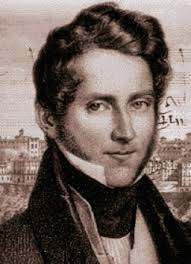 was staged in Milan and made him instantly famous (the 1957 staging of the opera in La Scala was one of Maria Callas’ greatest triumphs). Two years later, in 1832, he composed L'elisir d'amore, a two-act comic opera. In 1835 he wrote his absolute masterpiece, Lucia di Lammermoor. The opera premiered at the Teatro San Carlo in Naples on September 26, 1835, three days after the death of Vincenzo Bellini. With Rossini in retirement, Donizetti was left the reigning master of the Italian opera. Lucia became his most famous opera, performed world over. In 1838 Donizetti moved to Paris, following the steps of Rossini and Bellini. There he wrote La fille du régiment, another comic opera and also a huge success. Unfortunately, just five years later he became sick, both physically (probably syphilis) and mentally. He was moved into an institution in Paris, where he was visited by friends, Giuseppe Verdi among them, and then taken back to his native town, Bergamo. He lived there with the family of Scotti (his wife and children had died years earlier). Donizetti died on April 8, 1848 at the age 50. Here is Lucia’s famous Mad Scene with Joan Sutherland in the live 1964 performance at the Metropolitan opera, Silvio Varviso conducting (we had to cut the ovation at the end of the recording).Permalink
was staged in Milan and made him instantly famous (the 1957 staging of the opera in La Scala was one of Maria Callas’ greatest triumphs). Two years later, in 1832, he composed L'elisir d'amore, a two-act comic opera. In 1835 he wrote his absolute masterpiece, Lucia di Lammermoor. The opera premiered at the Teatro San Carlo in Naples on September 26, 1835, three days after the death of Vincenzo Bellini. With Rossini in retirement, Donizetti was left the reigning master of the Italian opera. Lucia became his most famous opera, performed world over. In 1838 Donizetti moved to Paris, following the steps of Rossini and Bellini. There he wrote La fille du régiment, another comic opera and also a huge success. Unfortunately, just five years later he became sick, both physically (probably syphilis) and mentally. He was moved into an institution in Paris, where he was visited by friends, Giuseppe Verdi among them, and then taken back to his native town, Bergamo. He lived there with the family of Scotti (his wife and children had died years earlier). Donizetti died on April 8, 1848 at the age 50. Here is Lucia’s famous Mad Scene with Joan Sutherland in the live 1964 performance at the Metropolitan opera, Silvio Varviso conducting (we had to cut the ovation at the end of the recording).Permalink